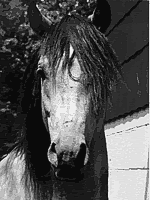Profiles
Sankofa’s Narrative
Quotes about the AMAAP
Sankofa's Narrative
Hello, my name is Sankofa...
 Sankofa means, in the Ghanaian language, "To return to get it". That is exactly what Miles and I have done during our recent journey, from New York city to the city of Los Angeles. I had the pleasure and privilege of carrying you, via the Internet, and Miles, on my back, into an historical and geographical time and place.
Sankofa means, in the Ghanaian language, "To return to get it". That is exactly what Miles and I have done during our recent journey, from New York city to the city of Los Angeles. I had the pleasure and privilege of carrying you, via the Internet, and Miles, on my back, into an historical and geographical time and place.
He's a school teacher, the Executive Director of the Black Heritage Riders, an excellent horseperson, and has a bio section dedicated to him, but this is my section and my story. When I was just 3 months old, Miles happend to come across me living with my Dam (mother), a Black Polish Arabian here in NJ. At the time I was just being weaned from my mother’s milk. I had no idea why he wanted me, or what was in store for me, but, he took me and became my mom and my dad.
I spent the first two years of my life on a 3 acres ranch in Piscataway with several other horses including a mare named Chardonay (who taught me how to behave around females), and an appendix (thoroughbred/quarter horse) they called Tiny Taboo (who helped me to mature). It was Miles who helped me develop my personality.
When I became of age and Chardonay could no longer resist my charm, Miles brought me to School Street where he could keep an eye on me. He said that as long as my behavior did not aggressively change, he would not be encouraged to change me from a stallion to a gelding (eliminating some of my vital organs). And so, because I enjoy thinking about some of the finer points to being a stallion, I kept my calm and eloquent demeanor.
By age 2, I had learned the basic voice commands of whoa, stand, walk, and trot and accepted a saddle and rider on the first introduction. I also learned how to pull a cart and a wagon which I think I enjoy more than a rider. At the age of 6 and 7, I competed in a couple of 25 and 50 mile endurance rides and enjoyed being out in the woods and open land. I was never allowed to go into a gallop or canter until I went on this journey at the age of 10.
As for the journey…well…that is another story for a later time, but I will say this… “Miles learned a lot from me”.
Back at home and missing the trail, watch for my continued story coming during the 3rd week of June,
Sankofa
return to top
Quotes about the AMAAP
"Young African American kids fortunate to see Dean [on the AMAAP journey] might just
go to bed with new possibilities in their heads. A black man on a horse in the 21st
century might just be a good omen. Miles Dean is aware his journey is different than
what could be undertaken by traveling to California by plane or train. His desire to
connect to the Black experience seems to be rooted in his passion to remind us that
America can be America again."
E. Etherlbert Miller, Director (and literary activist), African American
Resource Center, Howard University
"Efforts to help enlarge our nations understanding of the African-American experience
in America are very valuable, particularly those that help people to understand the national
scope of the story."
Chuck Hunt, Superintendent,
Fort Davis National Historic Site (A U.S. Army post that served as Regimental Headquarters
to all four Buffalo Soldier Regiments during the "Indian Wars".)
"There are two trends of thought that explain what manner of man Miles Dean is. One
says that...the universe will give you nothing without sacrifice and the other is...there is no
greater gift that a person can give than of themselves.
Mr. Dean is making a personal sacrifice with great physical and mental demands. He is making this
sacrifice for the most important segment of our society...the unborn."
Kamau Khalfani, Producer,
Under the Learning Tree Radio Show, WBAI, Pacifica Radio, New York
return to top

 Sankofa means, in the Ghanaian language, "To return to get it". That is exactly what Miles and I have done during our recent journey, from New York city to the city of Los Angeles. I had the pleasure and privilege of carrying you, via the Internet, and Miles, on my back, into an historical and geographical time and place.
Sankofa means, in the Ghanaian language, "To return to get it". That is exactly what Miles and I have done during our recent journey, from New York city to the city of Los Angeles. I had the pleasure and privilege of carrying you, via the Internet, and Miles, on my back, into an historical and geographical time and place.